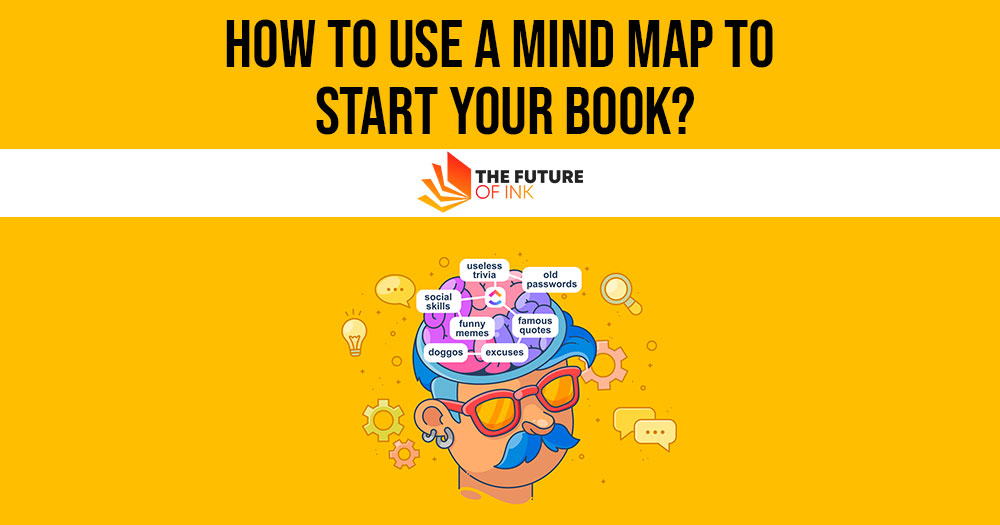Contents
Have you been struggling to start your book?
Many people don’t write books because they simply don’t know how to start. They possess an idea for a book, but they don’t know what to do with it. They can’t imagine how they get from the initial idea to the finished manuscript.
To accomplish this feat, I suggest using a method I call “The Brain Dump.” Others call it to mind mapping.
The name doesn’t really matter, only the methodology. It will take you from a book idea to a detailed book outline. This provides you with a guide to take you from start to finish, or, rather, “finished.”
To get you to use both sides of your brain—left and right, analytical and creative—mind mapping asks you to go through a brainstorming process where you free-flow ideas.
This allows all thoughts, ideas, and information you have on the topic of your book to rise to the surface of your mind.
You then “dump” them on a whiteboard, poster board, or computer screen. (More on this in a moment.)
After this first stage, which relies more on your more creative right brain, you allow your analytical left brain to organize the material into the structure of your book—a table of contents. With this outline, you know what your book will look like.

If you’ve done a really good job with this exercise and produced detailed chapter outlines, you’ll even know what subjects to cover in each chapter. (Read on for more information.)
How to Mind Map a Book
Post-It Note Version
The easiest way to complete a mind-mapping exercise involves purchasing a large poster board and some colored sticky notes, or Post It Notes.
Use the ones made of material you can write on. Follow these steps:
- Put a large Post It notes in the middle of the board; write your topic or tentative book title on it.
- Write related topics on smaller sticky notes. Use one color for this part of the exercise. Just stick them all over the board. Don’t worry about where you place them, or about organizing them, unless you are certain they are related topics; then you can group them together. This is the “brain dump” phase. Put everything you can possibly think of onto the board. Free associate. Fill the board to capacity. When you think you are done, think again.
- Organize the notes. Look for related topics. Pick up the notes and move them around.
- Consider which groupings are well suited to become chapters. More than likely, the ones with the most information, but you may have to break some of them into more than one chapter if you have an overabundance of notes on one topic. Use a different colored Post It Note at the top of each grouping to delineate a chapter; give it a chapter name.
When done, you should have 8-15 chapters—typical for a nonfiction book. To see this clearly, use a word processing program and type each chapter name or topic into an outline, or table of contents; it becomes a chapter.
Use each of the sticky notes in the groupings below the chapter title as a sub-topic to cover in your chapter. Write subheadings for the most important sub-topics and include this in a detailed table of contents to use as a writing guide.
Also Read: How to Leap into Writing and Publishing Your Next Book?
White Board or Poster Board Version
You also can do this exercise on a whiteboard or with a poster board using colored pens or markers.
Many people enjoy this method. Here are directions:
- In the center of the paper or board, print your book’s topic using a colored pen.
- Draw a circle around that topic.
- Using a different colored pen, draw a line from your topic to the first word or phrase that pops into your mind that is related to that topic. Circle the word or phrase. This is a subtopic that may become a chapter in your book. It could also become a subheading depending upon its importance.
- Draw a line from that word and jot down the next word or phrase that comes to mind. Since this is related, use the same colored pen.
- Repeat until you’ve run out of word associations.
- Now, return to your original topic and repeat the exercise with a different colored pen for a different subtopic. Continue until you have created ten to fifteen subtopics.
- Take the related subtopics and sub-subtopics, and arrange them into a table of contents for your book. Again, use the sub-subtopics as possible subheadings in your chapters.
- Place all the various sub-subtopics (additional related words and phrases) for each subtopic) in your expanded outline or table of contents.
You also can just free associate and put all your ideas on the board with no rhyme or reason and draw lines and circles using different colored pens later after your “brain dump.”
Also Read: Ten Digital Publishing Trends From the Experts
Computer Version
Or, if you are the techie type, you’ll enjoy mind mapping on your computer.
You can purchase mind mapping software or download free software.




